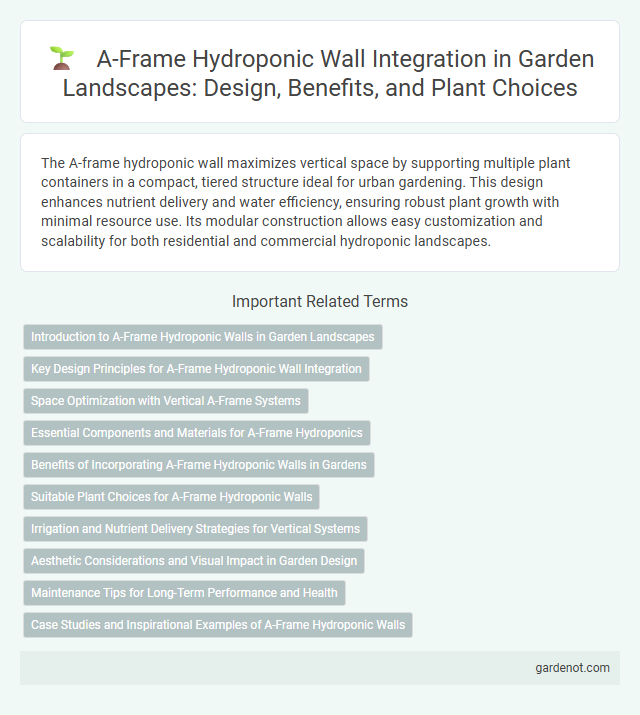The A-frame hydroponic wall maximizes vertical space by supporting multiple plant containers in a compact, tiered structure ideal for urban gardening. This design enhances nutrient delivery and water efficiency, ensuring robust plant growth with minimal resource use. Its modular construction allows easy customization and scalability for both residential and commercial hydroponic landscapes.
Introduction to A-Frame Hydroponic Walls in Garden Landscapes
A-frame hydroponic walls maximize vertical growing space by supporting plants in a tiered, angled structure that optimizes light exposure and air circulation. These walls use soilless nutrient-rich water solutions to promote faster growth and higher yields while conserving water compared to traditional gardening methods. Incorporating A-frame hydroponic walls in garden landscapes enhances aesthetic appeal and supports sustainable urban agriculture practices.
Key Design Principles for A-Frame Hydroponic Wall Integration
Key design principles for A-frame hydroponic wall integration include maximizing vertical space utilization to enhance plant density and growth efficiency. Incorporating adjustable nutrient delivery systems ensures optimal hydration and nutrient absorption tailored to diverse plant species. Structural stability with corrosion-resistant materials guarantees durability and maintenance ease in humid, nutrient-rich environments.
Space Optimization with Vertical A-Frame Systems
A-frame hydroponic walls maximize space efficiency by utilizing vertical structures that support multiple layers of plant growth in a compact footprint. These vertical A-frame systems enhance crop yield per square foot by enabling dense planting without compromising air circulation or light exposure. The angled design promotes optimal drainage and nutrient distribution, ensuring healthier plants and more sustainable urban gardening solutions.
Essential Components and Materials for A-Frame Hydroponics
A-frame hydroponic walls rely on a sturdy frame, commonly constructed from galvanized steel or treated wood, to support the vertical system and resist corrosion. Essential components include a water reservoir, submersible pump, grow trays or channels arranged in a cascading manner, and a nutrient delivery system to ensure consistent feeding of plants. Durable materials such as high-density polyethylene (HDPE) for trays and UV-resistant tubing for water circulation enhance the longevity and efficiency of the A-frame hydroponic wall.
Benefits of Incorporating A-Frame Hydroponic Walls in Gardens
A-frame hydroponic walls maximize vertical growing space, allowing gardeners to cultivate more plants within limited areas, significantly increasing yield per square foot. These structures enhance plant health by improving air circulation and light exposure, which reduces disease and promotes faster growth. Incorporating a-frame hydroponic walls also conserves water through efficient nutrient delivery systems, making them an eco-friendly solution for sustainable gardening.
Suitable Plant Choices for A-Frame Hydroponic Walls
A-frame hydroponic walls thrive with plants that require minimal root space and consistent moisture, such as leafy greens like lettuce, spinach, and arugula. Herbs including basil, mint, and parsley exhibit strong growth in these vertical systems, benefiting from efficient nutrient delivery and air circulation. Compact, fast-growing plants maximize yield in limited space, making them ideal candidates for A-frame hydroponic installations.
Irrigation and Nutrient Delivery Strategies for Vertical Systems
A-frame hydroponic walls utilize advanced irrigation techniques such as drip and ebb-and-flow systems to ensure uniform water distribution across vertical plant layers, promoting optimal growth. Nutrient delivery strategies focus on precise dosing and recirculation of nutrient-rich solutions, enhancing efficient absorption and reducing waste. Integration of automated sensors and timers allows real-time monitoring of moisture and nutrient levels, optimizing plant health and resource management in vertical hydroponic landscapes.
Aesthetic Considerations and Visual Impact in Garden Design
The A-frame hydroponic wall creates a striking vertical garden, maximizing green space while offering a modern, sleek aesthetic to outdoor environments. Its geometric structure enhances visual interest through layering and depth, making it an ideal focal point in contemporary garden design. Integrating vibrant plant varieties within this frame amplifies texture, color contrast, and seasonal dynamics, elevating the overall visual impact.
Maintenance Tips for Long-Term Performance and Health
Regularly inspect and clean A-frame hydroponic walls to prevent algae buildup and ensure optimal nutrient flow. Monitor water pH and nutrient levels weekly to maintain a balanced environment for plant growth and prevent system malfunctions. Replace worn components such as pumps and tubing promptly to sustain system efficiency and promote healthy plant development.
Case Studies and Inspirational Examples of A-Frame Hydroponic Walls
A-frame hydroponic walls have been successfully implemented in urban farming projects such as Singapore's NParks initiative, showcasing efficient vertical growth in limited spaces. Case studies reveal increased yields and reduced water usage using nutrient film technique (NFT) systems integrated into these structures. Inspirational examples include community gardens in New York City leveraging modular A-frame designs for scalable, sustainable food production.
A-frame hydroponic wall Infographic

 gardenot.com
gardenot.com